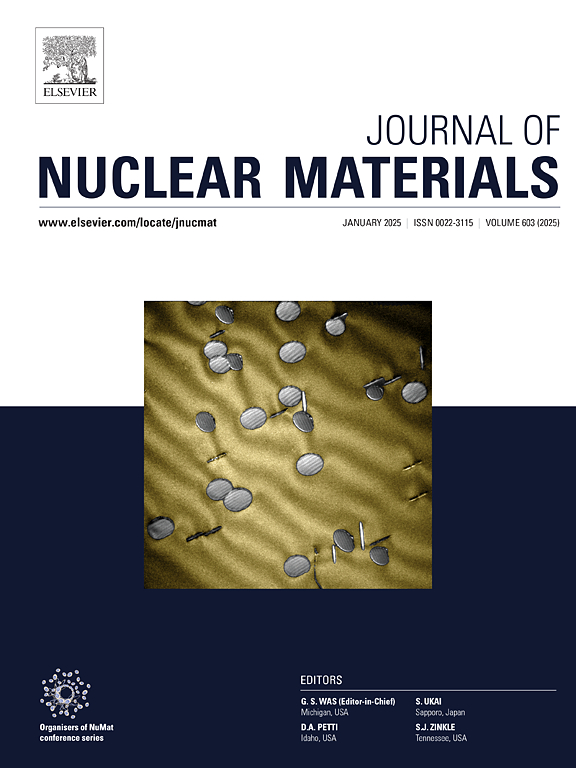锆微合金化对钇中氢扩散行为和氢化物相变的影响:第一性原理研究
IF 2.8
2区 工程技术
Q3 MATERIALS SCIENCE, MULTIDISCIPLINARY
引用次数: 0
摘要
由于氢的高密度(类似于中子质量)和优越的热稳定性,氢化钇已被认为是高温核反应堆环境中极好的中子慢化剂。微型核反应堆对大规模、无裂纹大块氢化钇的需求日益增长。然而,制造具有理想几何形状和结构的无裂纹氢化钇是具有挑战性的,而且钇的相对高的中子吸收截面阻碍了它的广泛应用。锆微合金化提供了一种很有前途的解决方案,由于锆的低中子吸收截面,它可以减轻氢化过程中的开裂,提高中子性能,从而扩大了钇基材料的应用范围。对氢原子和合金元素之间原子尺度相互作用的基本理解对于优化钇基合金的加工和减轻氢致开裂至关重要。在本研究中,采用第一性原理计算研究了纯钇和钇锆合金中氢的扩散行为和氢诱导相变。结果表明,锆的最佳浓度可以提高氢在块状材料中的扩散系数。此外,还确定了氢化钇的优选相变途径为{0001}HCP/{111}FCC &;& lt; 12¯10祝辞HCP / & lt; 1¯10在FCC。这些发现突出了氢在相变过程中的关键作用,并表明低浓度的锆促进了氢化钇的相变。所获得的机理见解将有助于开发用于先进核反应堆高温减速剂的钇基合金。本文章由计算机程序翻译,如有差异,请以英文原文为准。
The effect of zirconium-microalloying on hydrogen diffusion behavior and hydride phase transformation in yttrium: A first principles study
Yttrium hydride has been perceived as an excellent neutron moderator for high-temperature nuclear reactor environments, owing to the high density of hydrogen (similar to neutron mass) and superior thermal stability. There is a growing demand for large-scale, crack-free bulk yttrium hydride for the micro-nuclear reactor applications. However, fabricating crack-free yttrium hydride with desired geometry and configuration is challenging and the relatively high neutron absorption cross section of yttrium prevents its widespread use. Zirconium microalloying offers a promising solution by mitigating cracking during hydriding and enhancing neutronic performance due to zirconium’s low neutron absorption cross section, thus broadening the application of yttrium-based materials. A fundamental understanding of atomic-scale interactions between hydrogen atoms and alloying elements is essential for optimizing the processing of yttrium-based alloys and mitigate hydrogen-induced cracking. In this study, the first-principles calculations were employed to investigate hydrogen diffusion behavior and hydrogen-induced phase transformation in pure yttrium and yttrium-zirconium alloys. The results show that an optimal concentration of zirconium enhances the diffusion coefficient of interstitial hydrogen in the bulk material. Moreover, the preferred phase transformation pathway for yttrium hydride was identified, as {0001}HCP/{111}FCC & <110>HCP/<10>FCC. These findings highlight the pivotal role of hydrogen in phase transformation process and demonstrate that low zirconium concentrations promote the phase transformation of yttrium hydride. The mechanistic insights gained will aid in the development of yttrium-based alloys for high-temperature moderators in advanced nuclear reactors.
求助全文
通过发布文献求助,成功后即可免费获取论文全文。
去求助
来源期刊

Journal of Nuclear Materials
工程技术-材料科学:综合
CiteScore
5.70
自引率
25.80%
发文量
601
审稿时长
63 days
期刊介绍:
The Journal of Nuclear Materials publishes high quality papers in materials research for nuclear applications, primarily fission reactors, fusion reactors, and similar environments including radiation areas of charged particle accelerators. Both original research and critical review papers covering experimental, theoretical, and computational aspects of either fundamental or applied nature are welcome.
The breadth of the field is such that a wide range of processes and properties in the field of materials science and engineering is of interest to the readership, spanning atom-scale processes, microstructures, thermodynamics, mechanical properties, physical properties, and corrosion, for example.
Topics covered by JNM
Fission reactor materials, including fuels, cladding, core structures, pressure vessels, coolant interactions with materials, moderator and control components, fission product behavior.
Materials aspects of the entire fuel cycle.
Materials aspects of the actinides and their compounds.
Performance of nuclear waste materials; materials aspects of the immobilization of wastes.
Fusion reactor materials, including first walls, blankets, insulators and magnets.
Neutron and charged particle radiation effects in materials, including defects, transmutations, microstructures, phase changes and macroscopic properties.
Interaction of plasmas, ion beams, electron beams and electromagnetic radiation with materials relevant to nuclear systems.
 求助内容:
求助内容: 应助结果提醒方式:
应助结果提醒方式:


